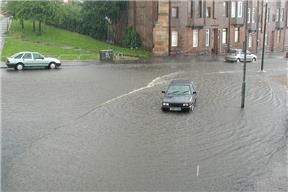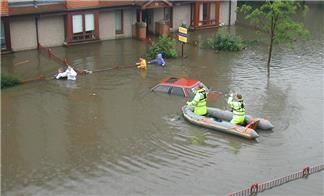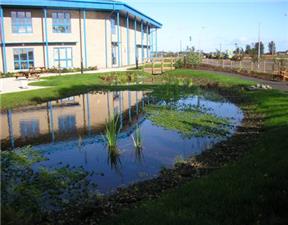Surface Water Flooding: Sustainable drainage to the ground
(Contributed by Rachel Dearden and Simon Price of the British Geological Survey)

An extreme rainfall event in Glasgow on 30 July 2002 caused
severe surface water flooding,
(Image courtesy of Glasgow City Council and Scottish Water © 2002)
During the exceptional rainfall events of summer 2007, floods inundated 7,300 businesses and 48,000 homes across the UK (PITT Review) with estimated costs of £3.2 billion. A review of the causes and consequences of these events (PITT review) identified that surface water was one of the primary causes of flooding. This type of flooding is particularly problematic in urban areas where rapid runoff from impermeable surfaces (roofs, pavements), exceeds the drainage capacity of that area leading to flooding in locations that are difficult to predict. The impacts are not restricted to water volume; the quality of water in receiving watercourses can also be compromised by pollutants entrained in run-off water and sewage contamination derived from Combined Sewer Overflow surcharging. There is significant emphasis currently within the UK on the management of surface water; this article provides a policy and technical background but also highlights the importance of understanding the groundwater conditions when designing schemes.
The Policy Context
DEFRA launched the governments ‘Future Water’ strategy for England and Wales in 2008. This called for sustainable management of surface water, which included facilitating water re-use, storage and infiltration into the ground to decrease the reliance on traditional drainage systems. To promote this change, the strategy advocated a shift in policy to withdraw the automatic right for developers to connect to the drainage system and also to provide clarification on the ownership and maintenance responsibilities for systems which infiltrate to the ground. The current lack of clarification in this matter is limiting the development of new schemes because of their reliance on adequate maintenance.
The outcomes from the ‘Future Water’ and the preceding ‘Making Space for Water’ strategies have resulted in the Floods and Water Management Act, which has partly been driven by the necessity for adaptation within the changing climate. The Act includes provision for the implementation of Sustainable Drainage Systems (SuDS) and National Standards for their design and performance to mitigate the impacts of surface water flooding. In England and Wales, Local Authorities have responsibility for managing flood risk. Planning Policy Statement 25 defines the levels of flood risk assessments required from regional to local scales, including the preparation of Surface Water Management Plans and optimising use of SuDS. These management plans, administered by local authorities, are a framework through which local partners can understand the causes of flooding, including surface water flooding, to determine the most cost effective, sustainable actions that are risk based and future proofed.
The role of sustainable drainage systems

Surface water flooding in Glasgow on 30 July 2002
(Image courtesy of Glasgow City Council and Scottish Water © 2002).
SuDS modify surface water flow to more natural rates, reducing the impact of urbanisation on flooding at source and elsewhere in the catchment. They also aim to protect water quality, first by managing the pollutant load at source and secondly by reducing the volumes of surface water reaching combined sewers which may directly overflow into watercourses. At a holistic level, SuDS increase the amenity and aesthetic value of urban areas and improve wildlife habitats and opportunities for biodiversity. The systems can take a variety of forms including rainwater re-use, storage or infiltration to the ground, via systems as simple as a water butt or as complex as a multistage system designed to remove pollutants and sediments before allowing direct infiltration to the subsurface.
In many areas of the UK, the subsurface has a huge capacity to attenuate surface water, providing opportunities for the installation of SuDS which infiltrate to the ground. In other areas however, subsurface conditions may be such that above ground re-use or storage schemes may be better placed.
Importance of groundwater conditions in the design of SuDS
There are a number of considerations that need to be taken into account when designing ground-draining systems. First is the ease with which stormwater will infiltrate the ground. This is not only dependent on the nature of the top soil (clay/sand/silt), but also what lies beneath. The permeability of those underlying deposits will dictate whether or not the ground is likely to accept the anticipated quantity of stormwater. In some systems where the infiltration capacity is constrained, excess water may be stored for delayed infiltration or allowed to overflow to drainage networks.

Sustainable drainage systems, such as attenuation ponds
can help reduce surface water flooding.
(Image courtesy of Glasgow City Council and Scottish Water © 2002).
The infiltration rate must be considered in conjunction with the water table elevation which for most schemes should be at least 1 m below the base of the SuDS scheme. This unsaturated thickness is necessary to ensure that there is space for a local rise in groundwater that may result from stormwater infiltration. A permanent unsaturated zone is also required in most systems as a final polishing step for the treatment of stormwater pollutants, the majority of which should be removed via above ground pre-treatment stages. Further to these design considerations, there are rare but significant geological hazards that may arise as a result of infiltrating water. Examples include voids and collapse features created by the dissolution of soluble rocks and minerals, down-slope waterlogging leading to increased landslide risk and changes in subsurface water content leading to ground compression and subsidence.
The use of infiltration to the ground in replacement of piped drainage systems is essentially aiming to return the groundwater recharge regime to something closer to pre-urbanisation conditions. A long-term effect of this may be a rise in groundwater levels over the catchment-scale. Whilst this provides benefits for river base flow, it may also have consequences for subsurface assets such as basements and utilities and, in more serious cases, for areas susceptible to groundwater flooding. The use of catchment-scale modelling can predict groundwater rise and therefore should be a consideration when planning multiple SuDS schemes in urban areas.
Whilst careful thought is needed in system design, sustainable drainage systems nevertheless are a promising approach for reducing the catastrophic effects of extreme flooding events such as those of the 2007 floods.
Links

Print this Page